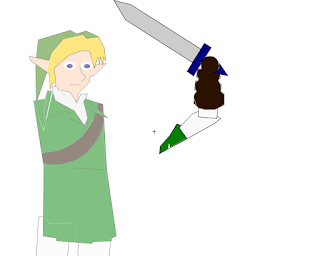Blog 3: Linking Animation with Combat Physics
Blog 3: Linking Animation with Combat Physics
By Payton Grady
For my vector animation, I chose Link from the Legend of Zelda franchise. While the animation is not complete, I have made substantial progress and have still considered the 12 principles. Throughout the drawing process, I have implemented concepts such as exaggeration, animation, and secondary action.
The Legend of Zelda franchise in general has had several different graphic styles, but even the most realistic of them had cartoonish elements such as arms or weapons enlarging when attacking. For example, Ocarina of Time involved Link's weapons enlarging as he attacked enemies. Another Nintendo franchise, Super Mario Bros., used this aspect several times in games such as Super Mario 64 and Super Mario Galaxy. This concept is known as exaggeration, "looking to create the hyper-real, a better presentation of what exists in real life" (Cooper 28). After reading this chapter, I thought about how I could incorporate this into Link. The previously mentioned games exaggerated movement perfectly by creating an animated-esque motion while still being consistent with the physics of the game. Mario's punching animation, for example, enlarges his hands without giving him any tactical advantage outside of highlighting his attacks. As for my animation of Link, I have designed two separate files for his sword: one for standard attacks and one for spin attacks. To incorporate this spin effect, I exaggerated the size of the sword in a way that it is longer and more wavy than the first one. While this is exaggerated, however, it is still true to the physics of the original model. If there is a way to do it in Animate or Inkscape, I might even add a motion blur.
Another factor I considered is anticipation. According to Jonathan Cooper, "Anticipation is used to prepare the viewer for an action, such as a crouch before a jump or an arm pulling back for a punch. It occurs in the natural world because a person jumping must first crouch with bended knees to give enough energy to lift off the ground, so it is used similarly in animation to sell the energy transfer of an action in a way the action alone cannot" (Cooper 30). I am currently incorporating this into Link's arm movements via his sword. I have converted Link's left arm to a symbol and set up a bone structure to pose him. While doing this, I realized that I could give his sword different motions while attacking people. For instance, he could point his sword out before an attack or rear back to warn the players that they are about to attack. This could even signify to the players what sort of attacks they are about to do. A light attack could have a faster buildup while a heavy attack could be much slower. Without communicating these details, players and even the engine used would not understand whatever is about to happen in-game.
The last of these is secondary action. Game Anim states that "Secondary actions are used to complement and emphasize the primary action of the character, adding extra detail and visual appeal to the base action" (Cooper 36). A secondary action can be anything provided it follows the main action. In this case, most of Link's main actions revolve around the use of his sword. I considered how I could follow this up with a secondary action and realized that I could add blocking. This may seem like a primary action but in this sense, it would be a combo move. Link could stab a character and if he was getting attacked by someone, he could deflect whatever hits him. He could also crouch or even jump if need be. This is important to my animation because in a video game, players would need to have different combat options and for every action is a plethora of secondary actions to choose from.
References
Cooper, J. (2019). Game anim: Video game animation explained. Boca Raton, Fl: CRC Press, Taylor &
Francis Group





Comments
Post a Comment